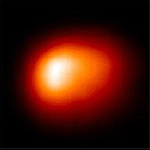June 6, 2000
CXC PR: 00-16
NASA's Chandra X-ray Observatory has imaged for the first time a "hot bubble" of gas surrounding a dying, Sun-like star. This large region of very hot gas in the planetary nebula BD+30 3639 has a peculiar shape and contains elements produced in the core of the dying star.
"The new Chandra image offers conclusive proof for the existence of the "hot bubble" that theorists have long predicted," said Professor Joel Kastner, of the Chester F. Carlson Center of Imaging Science at the Rochester Institute of Technology. Kastner leads a team of scientists who reported on this observation at the 196th national meeting of the American Astronomical Society in Rochester, New York.
The Chandra image shows a region of 3 million degree Celsius gas that appears to fit inside the shell of ionized gas seen by the Hubble Space Telescope. The optical and X-ray emitting regions of BD+30 3639, which lies between 5000 and 8000 light years away, are roughly one million times the volume of our solar system.
A planetary nebula (so called because it looks like a planet when viewed with a small telescope) is formed when a dying red giant star puffs off its outer layer, leaving behind a hot core that will eventually collapse to form a dense star called a white dwarf. According to theory, a "hot bubble" is formed when a new, two million mile per hour wind emanating from the hot core rams into the ejected atmosphere, producing energetic shocks and heating the interaction region to temperatures of millions of degrees. Previous X-ray observations hinted that X rays might be coming from a region larger than the central star but it remained for Chandra to provide definite proof.
The shape of the X-ray emission was a surprise to the researchers. "This suggests that the red giant atmosphere was not ejected symmetrically,"said Kastner. "It might be pointing to an unseen companion star,"
The spectrum shows a large abundance of neon in the X-ray-emitting gas. This indicates that gas contained in the hot bubble gas was dredged up from the deepest layers of the central star, where nuclear fusion altered the chemical composition of the gas prior to its being ejected. Thus the Chandra data may offer new insight into the process whereby dying stars enrich the Milky Way in fusion products.
The observation was made in March 2000 using the Advanced CCD Imaging Spectrometer (ACIS). Kastner's collaborators on the project are Prof. Noam Soker of the University of Haifa, Israel; Prof. Saul Rappaport of MIT; Dr. Ruth Knill-Dgani of the University of Texas, Austin; and Dr. Saeqa Vrtilek of the Harvard-Smithsonian Center for Astrophysics.
The ACIS instrument was built for NASA by the Massachusetts Institute of Technology, Cambridge, and Pennsylvania State University, University Park. NASA's Marshall Space Flight Center in Huntsville, Ala., manages the Chandra program. TRW, Inc., Redondo Beach, Calif., is the prime contractor for the spacecraft. The Smithsonian's Chandra X-ray Center controls science and flight operations from Cambridge, Mass.
High resolution digital versions of the X-ray image (JPG, 300 dpi TIFF ) and other information associated with this release are available on the Internet at:
MEDIA CONTACTS
Steve Roy
Marshall Space Flight Center, Huntsville, AL
Phone: 256-544-6535
Susan Murphy
RIT University News Services, Rochester, NY
Phone: 716-475-5061
Dr. Wallace Tucker
Chandra X-ray Observatory Center, CfA, Cambridge, MA
Phone: 617-496-7998



